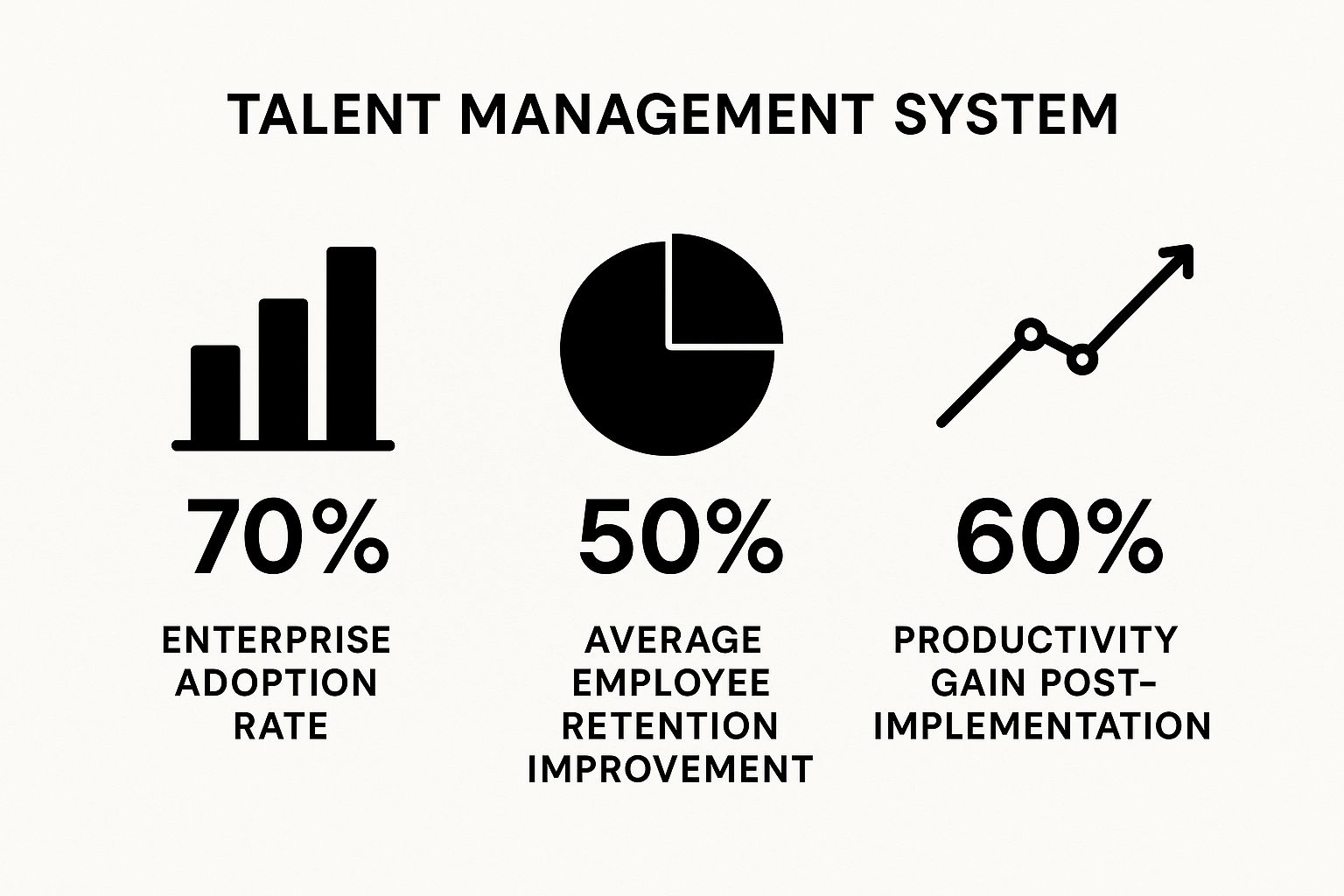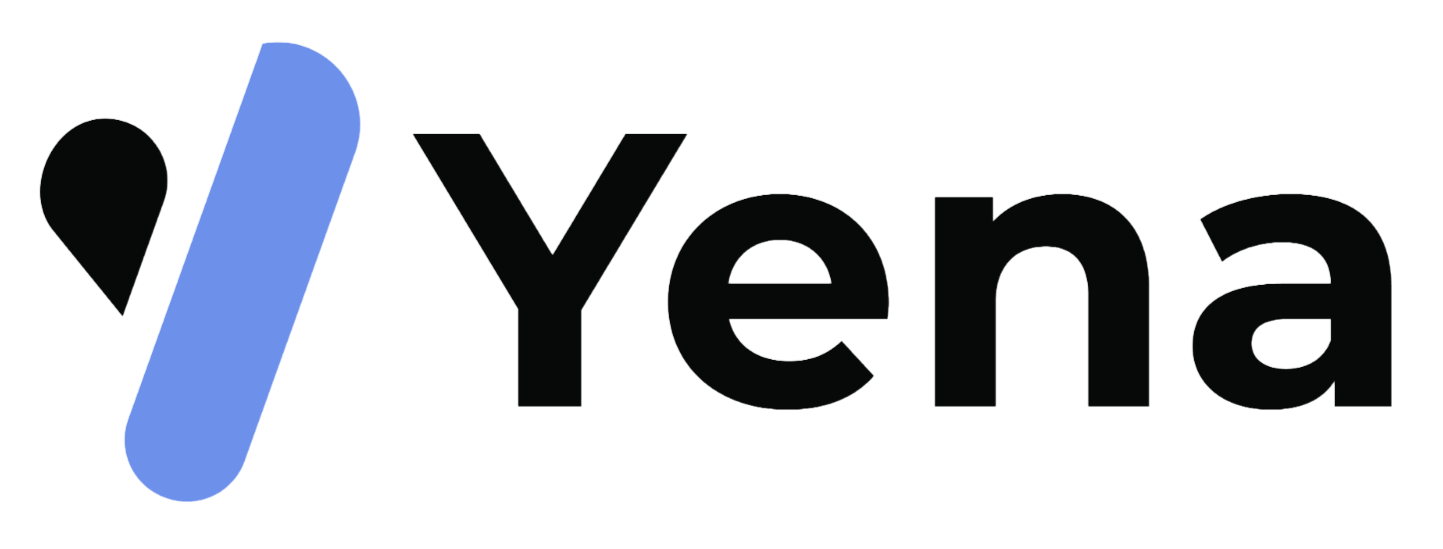Enhance Your Talent Management System for Better Results
- Janis Kolomenskis
- Jun 4
- 14 min read
Building Your Talent Management System Foundation
A talent management system (TMS) is so much more than just software. It's the very foundation upon which thriving organizations are built! It's the integrated system that helps businesses, not just in Latvia, but everywhere, attract, develop, and keep their amazing talent. This means going beyond old-school HR practices and adopting a more strategic, holistic approach to managing your most valuable asset: your people. This is essential for companies that want to not just survive, but truly excel!
This infographic visualizes key metrics highlighting the effectiveness of talent management systems, including enterprise adoption, employee retention improvement, and productivity gains.

As the infographic shows, businesses using these systems see significant improvements. The 70% enterprise adoption rate highlights how many companies recognize the value of talent management systems. The impressive impact on employee retention (a 50% improvement) and productivity (a 60% gain) clearly shows the positive return on investment a good TMS can deliver.
To understand more deeply the differences between traditional HR and a Modern Talent Management System, let's look at the table below:
"Traditional HR vs. Modern Talent Management System Comparison"
Side-by-side comparison showing the key differences between traditional HR practices and integrated talent management systems
Aspect | Traditional HR | Modern Talent Management System | Business Impact |
|---|---|---|---|
Recruitment | Manual processes, paper-based applications | Automated applicant tracking, online assessments | Reduced time-to-hire, improved candidate quality |
Onboarding | Lengthy paperwork, inconsistent processes | Digital onboarding, automated workflows | Faster integration of new hires, enhanced employee experience |
Performance Management | Annual reviews, limited feedback | Continuous feedback, real-time performance data | Improved employee performance, increased engagement |
Learning & Development | Disconnected training programs | Integrated learning platforms, personalized development plans | Enhanced employee skills, increased retention |
Succession Planning | Informal identification of successors | Data-driven talent pools, structured development programs | Improved leadership pipeline, reduced risk of talent gaps |
This table clearly outlines how a modern TMS can positively impact various aspects of HR, leading to a more efficient and strategic approach to talent management.
Experts in Latvia and Lithuania have been evaluating HR practices and emphasizing the need for effective talent management systems. Figure, for example, offers talent management systems and organizational structure audits to help businesses refine their HR practices. This is all about helping businesses in the region attract, retain, and develop their best people, making them more competitive globally!
Core Components of an Effective TMS
Building a strong TMS foundation means thinking carefully about its key parts. These components work together to create a seamless system that supports the entire employee journey.
Talent Acquisition: This is about attracting and recruiting the right people. A good TMS provides tools for efficient job posting, applicant tracking, and candidate assessment.
Performance Management: This part focuses on clear expectations, regular feedback, and evaluating how employees are doing. A strong TMS supports ongoing performance conversations and gives a space for reviews.
Learning and Development: This critical piece focuses on helping employees grow their skills and knowledge. A TMS can work with learning management systems and offer ways to track employee progress.
Succession Planning: Getting ready for future leaders is so important for long-term success. A TMS can help find high-potential employees and create development plans to get them ready for leadership roles.
By prioritizing these core components, businesses in Latvia can establish a rock-solid foundation for their talent management system and achieve lasting competitive advantages. This proactive approach not only benefits each individual employee but makes the entire organization stronger, letting it adapt and thrive in today's ever-changing business world.
Mastering Strategic Talent Acquisition That Actually Works
Forget outdated job postings and crossing your fingers! Leading organizations in Latvia region are turning recruitment into a serious competitive edge. They're ditching reactive hiring and proactively building impressive talent pipelines, powered by dynamic talent management systems.
This proactive approach involves anticipating future talent needs. For example, data analytics within a talent management system can pinpoint talent gaps before they affect your bottom line. This gives you a head start in connecting with potential candidates. Plus, a powerful employer brand, boosted by your talent management system, helps attract passive candidates – those talented individuals who aren't actively job hunting but are open to exploring exciting opportunities.
This means attracting top-tier talent isn't just about filling current openings; it's about cultivating a network of skilled professionals excited about your company. Even for those not hired immediately, a positive candidate experience is key. This builds a stellar reputation and attracts future applicants. Want to craft job descriptions that truly resonate? Check out our guide on How to master... to attract and retain top employees!
Optimizing Recruitment Workflows
High-performing companies don't just fill positions; they build sustainable talent pipelines. They optimize their recruitment workflows for maximum efficiency and quality. A talent management system is essential here, streamlining everything from initial contact to onboarding. This includes automating tasks, managing candidate communication, and tracking progress effectively.
However, Lithuania, while making progress in talent management, still faces hurdles attracting international talent. In the 2020 Global Talent Competitiveness Index (GTCI), Lithuania ranked 35th out of 132 countries, trailing behind its Nordic neighbors. This underscores the need for improvement in attracting and retaining highly skilled professionals. Learn more about this important topic.
Measuring Acquisition Success
Measuring true acquisition success means going beyond simple time-to-hire metrics. With a talent management system, you can analyze data on quality of hire, cost per hire, and the long-term performance of new employees. This valuable data reveals which recruitment channels are most effective and which candidate profiles lead to the best long-term results. This empowers you to continually refine your recruitment strategy and ensure that every new hire contributes to your organization's overall success.

Driving Performance Through Development That Matters
Performance management shouldn't be a dreaded yearly chore. Think of it instead as an exciting opportunity to fuel growth and boost team engagement! This is especially important in Latvia, where a strong, skilled workforce is key to business success. Top-notch talent management systems achieve this by connecting individual goals with company objectives, all while keeping employees genuinely excited about their work.
Designing Engaging Performance Management
So, how do you create this kind of dynamic environment? You design performance management processes that offer valuable feedback, set clear expectations, and provide visible paths for career advancement. This transparency empowers employees and gives them a solid understanding of how their work contributes to the company's overall success.
Imagine a system that not only assesses performance but also suggests personalized learning paths based on individual strengths and weaknesses. This goes beyond simply tracking output; it's about nurturing individual potential! This approach creates a more engaged and motivated team.
Personalized Development Journeys
Today’s top talent management systems combine learning management, mentoring programs, and skill assessments to craft these personalized development journeys. This transforms learning from an obligation into an experience employees actually want.

By linking learning opportunities directly to performance goals, employees see the immediate benefits of investing in their own growth. This connection reinforces the value of continuous learning and strengthens their commitment to the company's success. You might be interested in: Top Recruiting Best Practices to Attract Talent in 2025.
Overcoming Performance Management Challenges
Even the best programs can face hurdles. A common issue is inconsistent feedback. Another is a disconnect between development opportunities and actual career progression. By addressing these issues proactively, companies can build a culture of continuous improvement and accountability. Performance management becomes an ongoing process, not just a once-a-year event.
Measuring the Impact of Development
Finally, measuring the impact of your development investments is crucial. This means looking beyond just tracking participation in training programs. It means assessing the real impact on both employee satisfaction and business outcomes. Are your employees more engaged? Are they taking on new challenges and contributing more effectively to team goals?
These are the key questions that will reveal the true return on investment of a well-implemented talent management system. A system focused on development is an investment in your most valuable resource: your people. By fostering growth and providing opportunities for advancement, you create a more engaged, skilled, and ultimately more successful workforce. This, in turn, strengthens the entire organization and sets it up for lasting success in the competitive Latvia market.
Creating Leadership Pipelines That Deliver Results
Building a powerful leadership team in the Latvia region isn't a matter of luck or wishful thinking. It takes a focused, strategic approach, and that's precisely where a robust Talent Management System (TMS) shines. A TMS helps you pinpoint high-potential employees early – even before they're on everyone's radar – and provides the framework to cultivate their growth.
Identifying High-Potential Employees
A core function of any TMS is identifying individuals with leadership potential. This goes beyond simply looking at current performance. A TMS allows for a more holistic assessment, considering vital factors like adaptability, problem-solving skills, and emotional intelligence. It's like spotting future leaders before they even realize their own potential! This early identification allows for strategic investment in their development, preparing them for the challenges of leadership roles.
Developing Future Leaders
Once you've identified your rising stars, a TMS provides the structure for focused development pathways. These pathways equip individuals with the specific skills they need to succeed within your organization. This could include specialized training programs, mentoring opportunities for deep growth, or stretch assignments that push them beyond their comfort zones. It’s not just about creating good managers; it’s about cultivating exceptional leaders who can drive your organization forward. A TMS can also facilitate personalized development plans tailored to each individual’s strengths and areas for growth, making learning more engaging and effective.
Succession Planning and Business Continuity
Leadership development isn’t just about future growth; it's about ensuring your organization can thrive no matter what. A TMS enables thoughtful succession planning by identifying and preparing internal candidates to step into key leadership roles when they become available. This minimizes disruption and maintains stability during transitions. It’s about having the right people ready to take the reins, ensuring a seamless handover and preserving valuable institutional knowledge.
Balancing Internal and External Talent
While developing internal talent is essential, sometimes strategic external hires are necessary. A good TMS helps you strike the perfect balance. It gives you the tools to analyze your existing talent pool, pinpoint any leadership gaps, and make informed decisions about whether to promote from within or look outside the organization. This balanced approach ensures you build the strongest possible leadership team, blending internal expertise with fresh perspectives. Furthermore, a TMS helps measure the return on investment (ROI) of your leadership development programs, demonstrating their value to stakeholders and ensuring continued support for your initiatives. By tracking metrics like promotion rates and leadership bench strength, you can showcase the positive impact of a well-implemented TMS on your organization's leadership pipeline and overall success.
Leveraging Technology For Talent Management Excellence

Technology is transforming the way we handle talent! But simply buying the latest talent management system (TMS) isn't the magic bullet. True success comes from a strategic implementation that makes your current HR processes better, not more burdensome. This is especially important for businesses in Latvia looking to sharpen their talent strategies.
Selecting And Integrating The Right Technologies
Picking the right TMS requires careful thought. Top organizations are prioritizing systems with AI-powered recruiting tools. These awesome tools offer better candidate matching and predictive analytics. Imagine identifying retention risks before employees even think about leaving! These systems make performance management a breeze and deliver actionable insights to fuel smart decision-making. Want to dive deeper? Check out our article on Essential Recruiting Metrics to Improve Hiring in 2025. This shift allows HR teams in the Latvia region to focus on big-picture strategy, not getting bogged down in administrative tasks.
Smooth integration with your current systems is also key. Your new TMS should work with your existing tools, not against them. Look for platforms that offer open APIs and adaptable integration options. This ensures a smooth transition and minimizes disruptions to your everyday HR work.
Practical Strategies For Data-Driven Talent Management
Want effective talent management? You need data-driven decisions! A great TMS delivers the data you need to automate routine tasks, freeing up your HR team to connect with employees on a personal level.
This powerful combination of automation and the human touch creates a much more personalized employee experience, leading to higher engagement and better retention.
To give you a clearer picture, let's look at some key features and benefits:
Here’s a handy table summarizing the essential features and advantages of implementing a robust Talent Management System:
Key Talent Management System Features and Benefits
Comprehensive breakdown of essential system features and their corresponding business benefits
Feature | Functionality | Business Benefit | Implementation Priority |
|---|---|---|---|
Recruitment | AI-powered candidate matching, automated screening | Reduced time-to-hire, improved quality of hires | High |
Performance Management | Real-time feedback, goal tracking, performance reviews | Increased employee engagement, improved performance visibility | High |
Learning & Development | Personalized learning paths, skills gap analysis, online training | Enhanced employee skills, improved career development | Medium |
Compensation & Benefits | Automated payroll, benefits administration | Reduced administrative burden, improved accuracy | Medium |
Succession Planning | Identification of high-potential employees, development plans | Improved leadership pipeline, reduced risk of key talent loss | Low |
This table highlights how a well-implemented TMS can bring numerous advantages, from streamlined recruiting to more effective performance management. The implementation priorities help you focus on the most impactful features first.
This data empowers you to personalize development programs, pinpoint skill gaps, and design targeted training. This personalized approach encourages employee growth and boosts overall team performance. It's all about using data to enhance human insights!
Addressing Implementation Challenges And Measuring ROI
Bringing in new technology always comes with its own hurdles. Successful adoption takes careful planning and smart change management. This involves clear communication with everyone involved, thorough training for users, and ongoing support during the entire implementation process.
Measuring the return on investment (ROI) of your technology is crucial. A good TMS provides metrics to track important key performance indicators (KPIs) like time-to-hire, cost-per-hire, and employee engagement scores. By focusing on these metrics, organizations in Latvia can prove the real benefits of their tech investments and ensure ongoing support for their talent management plans.
Measuring What Matters In Talent Management Success
A truly successful talent management system isn't just about implementing the right software—it's about measuring the right things! Forget getting bogged down in endless data; instead, zero in on the metrics that genuinely matter. We're talking about the metrics that have a direct impact on your business value and showcase just how effective your talent management initiatives are, particularly within Latvia. This means carefully selecting Key Performance Indicators (KPIs) that paint a clear and compelling picture of your talent pipeline.
Key Performance Indicators That Drive Success
Think of your talent management system as a high-performance engine. To keep it running smoothly, we need to keep a close eye on its vital signs. These KPIs are the gauges that tell us everything about its efficiency:
Employee Engagement Scores: These are incredibly valuable for predicting employee retention. High engagement means a more dedicated and committed workforce, which, in turn, reduces costly employee turnover and keeps your teams stable and productive.
Time-to-Productivity: How long does it take for your new hires to hit the ground running? A shorter time-to-productivity equals a faster return on your recruitment investment, allowing new team members to contribute to business goals more quickly.
Internal Promotion Rates: This metric is a fantastic indicator of the effectiveness of your development programs. A strong internal promotion rate shows that your employees are developing their skills and advancing within the company, a sure sign of a thriving talent ecosystem.
Quality-of-Hire Metrics: Beyond just filling positions, are your new hires performing at the level you anticipated? Monitoring quality-of-hire reveals how effective your recruitment strategies are and helps you fine-tune your approach to attract top-tier talent within Latvia.
Remember, these KPIs aren't just numbers on a spreadsheet; they're powerful tools you can use to optimize your talent management system for maximum impact.
Predictive Analytics and Proactive Talent Management
Forward-thinking organizations are pushing the boundaries of measurement by using predictive analytics. This empowers you to anticipate talent challenges before they affect your business. Imagine being able to spot patterns that hint at a potential rise in employee turnover—predictive analytics makes that possible. This gives you valuable time to address any underlying issues and retain your valued team members.
This proactive strategy helps you avoid expensive reactive measures, allowing you to adjust your talent management strategies in real-time. And speaking of Latvia, talent management in Latvia is closely tied to economic growth and productivity. While Latvia's productivity has frequently exceeded the EU average, there's always room to grow. This emphasizes the importance of robust talent management strategies to nurture a highly skilled workforce and drive innovation. Learn more about this important connection.
Building Actionable Reporting Systems
Data without context is meaningless. Your talent management system should provide clear, concise reports that offer actionable insights, not an overwhelming deluge of data. This means designing dashboards that highlight key trends and make it easy for you to track progress toward your talent management objectives.
Regular system audits are essential for spotting areas where you can make improvements. Think of these audits as routine health checks for your talent management system, ensuring everything is running at peak performance.
By consistently refining your talent management processes based on reliable data, you create a system that adapts to your evolving business needs and the dynamics of the Latvia region. This commitment to data-driven decisions is the cornerstone of a sustainable talent pipeline and long-term success.
Finally, don’t underestimate the importance of communicating the ROI of your talent management efforts to your stakeholders. Present your findings in a way that aligns with their business priorities, clearly demonstrating how a strong talent management system directly contributes to the bottom line. This open communication builds support for your initiatives and ensures continued investment in your talent management program.
Key Takeaways For Talent Management System Success
A successful Talent Management System (TMS) is so much more than just software. It's a dynamic strategy that fuels organizational growth, especially in competitive markets like Las Vegas. This section highlights key insights and actionable strategies for crafting a TMS that attracts, develops, and retains top-tier talent, ultimately driving measurable results and boosting your bottom line.
Evaluating Potential Systems: A Checklist for Success
Choosing the right TMS is absolutely crucial. Use this checklist to confidently navigate the selection process:
Comprehensive Features: Does the system offer integrated modules for key functions like recruitment, performance management, learning & development, and succession planning? Look for valuable features such as AI-powered recruitment tools, customizable performance review templates, and personalized learning paths.
Seamless Integration: Will the TMS integrate smoothly with your existing HR systems, such as ADP for payroll and benefits administration? Seamless integration is essential for efficient data flow and prevents extra work for your HR team.
Scalability and Usability: Can the system adapt to your company's growth and is it user-friendly for everyone? A TMS should be easy to navigate, even for non-technical users, and offer the flexibility to scale as your organization expands.
Robust Reporting and Analytics: Does the system provide actionable insights via clear dashboards and reporting tools? This empowers data-driven decisions and helps showcase the return on investment (ROI) of your TMS.
Dedicated Support and Training: Does the vendor offer ongoing support and training resources? Comprehensive training and reliable support are essential for successful implementation and long-term success with your TMS.
Implementation Timeline: Planning for Success
Implementation requires careful planning. A realistic timeline should always include these phases:
Needs Assessment: Carefully analyze your current talent management processes to pinpoint specific areas for improvement. This assessment clarifies your unique requirements.
System Selection: Evaluate different TMS options based on your needs and budget. Remember to involve key stakeholders for buy-in and a better fit.
System Configuration and Customization: Tailor the system to match your organization’s specific workflows. This customization ensures the TMS supports your processes.
Data Migration and Integration: Transfer existing talent data into the new system and integrate it with other HR platforms. Careful data migration ensures accuracy.
Training and Change Management: Offer comprehensive training to all users and address any resistance to adopting the new system.
Go-Live and Ongoing Support: Launch the system with confidence! Providing ongoing support to users is key for long-term success.
Defining Success Metrics: Measuring What Matters
Measuring the impact of your TMS is essential. Key metrics to consider:
Reduced Time-to-Hire: Track how long it takes to fill open positions. Faster hiring means quicker contributions from new team members.
Improved Quality of Hire: Assess the performance of new hires and their contributions. Quality of hire impacts productivity and results.
Increased Employee Engagement: Monitor employee satisfaction and engagement. Highly engaged employees are more productive.
Improved Retention Rates: Track employee turnover and identify trends. Lower turnover saves money on recruitment.
Enhanced Leadership Development: Measure the effectiveness of your leadership development programs. Strong leadership is essential for growth.
Building a Talent Management Culture
A truly successful TMS thrives in a supportive culture. This involves:
Leadership Buy-in: Get support from senior management. Leadership backing shows the importance of talent management.
Continuous Feedback: Encourage regular feedback between managers and employees. This fosters open communication.
Development Opportunities: Provide opportunities for professional growth. This strengthens engagement.
Recognition and Rewards: Implement programs that recognize and celebrate achievements. This motivates employees.
By focusing on these key takeaways, organizations can build a talent management system that drives substantial success. This creates a competitive edge by attracting, developing, and retaining top talent, ultimately boosting business performance and driving organizational growth. Ready to transform your talent management process? Yena Hiring OS is an AI-powered ATS built to delight both candidates and recruiters. With features like real-time application tracking, personalized communication, and branded career pages, Yena can reduce time-to-hire and boost candidate satisfaction. Learn more and request a demo at yena.ai.

Comments